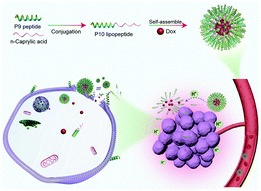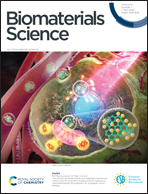Development of anticancer peptides with low hemolysis, high penetrating membrane activity, certain analgesic activity and the synergistic anticancer effect†
Abstract
Herein, an amphiphilic cationic α-helical anticancer lipopeptide, P10 with low toxicity and high penetrating membrane activity was developed. This lipopeptide could self-assemble into stable spherical aggregates in aqueous solution and encapsulate Dox with a hydrophobic structure to form the P10@Dox nanomedicine. The Dox encapsulation efficiency was 81.3% ± 3.48% and its release from the P10@Dox nanomedicine had the characteristics of slow release and pH response. The in vitro experiments showed that the P10 lipopeptide had low toxicity, excellent membrane penetrating activity and high serum stability, the release of Dox from P10@Dox in cells was time and concentration dependent, and the P10@Dox nanomedicine played a good anti-cancer role. The animal experiments and tissue sections showed that the P10 lipopeptide and P10@Dox nanomedicine both had low hemolysis, and P10@Dox nanomedicine not only greatly reduced the toxicity and side effects of Dox, but also effectively inhibited the tumor growth. Additionally, it was surprising that P10 exhibited certain analgesic activity, which could reduce the accompanying cancer pain, while playing an effective role in cancer therapy. Thus, the results showed that the P10 lipopeptide can be used as an ideal drug carrier and it has great application potential in the field of clinical cancer therapy.

- This article is part of the themed collection: Biomaterials Science Recent HOT Articles


 Please wait while we load your content...
Please wait while we load your content...